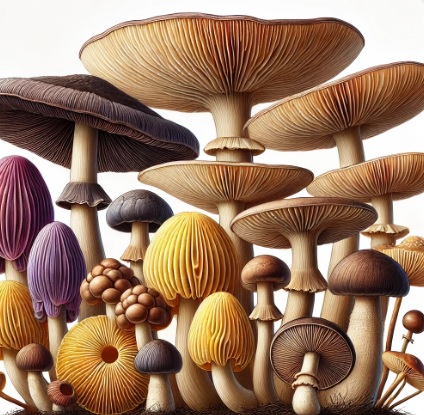The Strophariaceae family is a group of fungi within the order Agaricales, which includes various species of mushrooms, many of which are notable for their hallucinogenic, medicinal, or ecological significance. This family comprises around 60 genera and includes fungi that are primarily found in woodlands, grasslands, and other terrestrial habitats. Some species in this family are known for their role in breaking down organic matter, while others, such as those in the Psilocybe genus, are famous for their psychoactive properties.
General Description
The Strophariaceae family is characterized by several common features:
- Cap: The fruiting bodies of the fungi in the Strophariaceae family typically have convex to bell-shaped caps, which are often smooth or slightly scaly. The cap color can vary from light brown, tan, or reddish to darker hues, depending on the species.
- Gills: The gills under the cap are usually crowded, free, or slightly attached to the stem. They are typically pale to dark in color and can darken with age as the spores mature.
- Stem: The stem of Strophariaceae mushrooms is typically slender, central, and fibrous. The stem may or may not have a ring, and in some species, the stem can have a slightly bulbous base.
- Spores: The spores of fungi in this family are typically dark, ranging from purple-brown to black, and are released from the gills as the cap matures.
Chemical Composition
The fungi in the Strophariaceae family contain various bioactive compounds, some of which are of medicinal, psychoactive, or ecological importance:
- Psilocybin and Psilocin: Species of the Psilocybe genus, such as Psilocybe cubensis, are known for their psychoactive compounds, psilocybin and psilocin. These compounds have hallucinogenic properties and are used in certain cultural and spiritual practices.
- Triterpenes and Sterols: Some species in the Strophariaceae family produce triterpenes and sterols, which can have antimicrobial and anti-inflammatory properties.
- Enzymes: Many species in this family, particularly the decomposers, produce enzymes that break down organic matter such as lignin and cellulose, playing a crucial role in nutrient cycling within ecosystems.
Physical Properties
The physical characteristics of Strophariaceae fungi are generally consistent across species:
- Cap: The cap is often convex to bell-shaped, and its surface can be smooth or slightly scaly. The color of the cap can vary significantly, but it is typically brown or tan.
- Gills: The gills are pale when young, but as they mature, they become dark, ranging from purple-brown to black.
- Stem: The stem is usually central, fibrous, and may or may not have a ring. Some species have a bulbous base, and the stem color often matches or is slightly lighter than the cap color.
- Spores: The spores of Strophariaceae fungi are typically dark and release from the gills to disperse, forming dark spore prints.
Ecological Role
Fungi in the Strophariaceae family play a significant role in ecosystems:
- Decomposers: Many species are saprophytic, meaning they break down dead organic matter, such as wood, leaves, and plant debris. This process is essential for nutrient cycling in ecosystems and helps return organic matter to the soil.
- Symbiosis: Some species in this family form mycorrhizal relationships with plants, aiding in nutrient exchange between the fungi and the plants.
Medicinal and Psychoactive Applications
- Psilocybin Mushrooms: The Psilocybe genus includes mushrooms like Psilocybe cubensis, which contain psilocybin and psilocin. These compounds are well-known for their psychoactive effects, inducing altered states of consciousness, visual and auditory hallucinations, and spiritual experiences. Psilocybin mushrooms have been studied for their potential therapeutic effects in treating depression, anxiety, and PTSD.
- Anti-inflammatory and Antimicrobial Properties: Some species in the family, including Stropharia rugosoannulata, have shown antimicrobial and anti-inflammatory properties in laboratory studies, indicating potential for use in medicinal formulations.
Environmental and Safety Considerations
- Psychoactive Effects: While species like Psilocybe cubensis are known for their psychoactive properties, the use of psilocybin mushrooms should be approached with caution due to the potential for psychological effects, including anxiety, paranoia, and hallucinations. Proper identification is crucial, as misidentifying mushrooms can lead to toxicity.
- Toxicity: Not all mushrooms in the Strophariaceae family are edible or safe to consume. Some species can be toxic, and consumption of the wrong species can lead to poisoning or gastrointestinal distress. It is important to identify mushrooms accurately before consumption and seek expert advice when foraging for wild mushrooms.
INCI Functions
- Antioxidant: Some species produce bioactive compounds with antioxidant properties, which help protect cells from oxidative damage.
- Anti-inflammatory: Certain species have shown potential for reducing inflammation, which can be beneficial in treating conditions like arthritis.
- Antimicrobial: Several species produce compounds that are active against bacteria and fungi, which may be utilized in natural treatments.
Conclusion
The Strophariaceae family is a diverse group of fungi, with species that have significant ecological, medicinal, and psychoactive value. The Psilocybe genus, with species such as Psilocybe cubensis, is particularly famous for its hallucinogenic effects due to the presence of psilocybin and psilocin, which have been studied for their therapeutic potential. Additionally, some species in this family play a crucial role in decomposing organic matter and maintaining ecosystem health.
![]() Strophariaceae
Strophariaceae 

